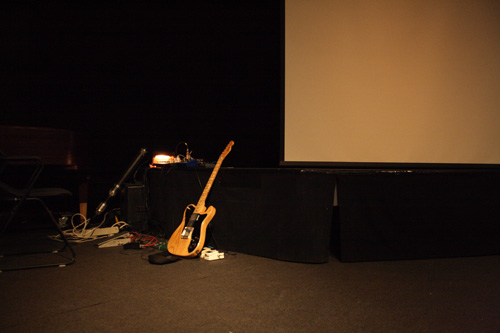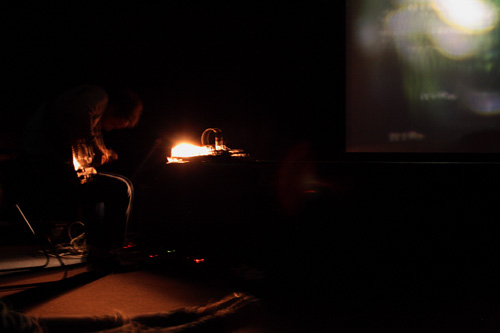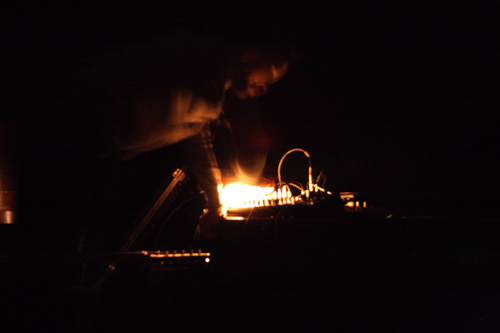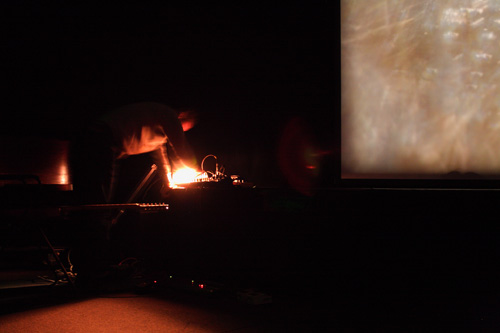|
|
 |
Charlemagne Palestine
Four Manifestations on Six Elements (1973)
|
|
|
 |
Terry Riley
Reed Streams (1966)
|
|
|
![31 VII 69 10:26 - 10:49 PM / 23 VIII 64 2:50:45-3:11 AM [aka The Black Record]](http://static.rateyourmusic.com/album_images/s601105.jpg) |
La Monte Young
31 VII 69 10:26 – 10:49 PM / 23 VIII 64 2:50:45-3:11 AM [aka The Black Record] (1969)
|
|
|
 |
Steve Reich
Four Organs / Phase Patterns (1970)
|
|
|
|
Phill Niblock
Nothin’ To Look At Just A Record (1982)
|
|
|
 |
Henry Flynt
You Are My Everlovin / Celestial Power
|
|
|
 |
Tony Conrad with Faust
Outside the Dream Syndicate (1972)
|
|
|
 |
Jon Gibson
Two Solo Pieces (1977)
|
|
|
 |
Remko Scha
Machine Guitars (1982)
|
|
|
 |
Terry Fox
Berlino / Rallentando (1988)
|
|
|
 |
Richard Youngs
Advent (1990)
A three-part composition for piano, voice, and ultra-nasty oboe and electric guitar, Advent indicated signs of life in a genre long dormant in the 80s ‘experimental’ scene. It continues the tradition from [Terry Riley’s] Reed Streams on down with gusto. |
|
|
 |
Alvin Lucier
Music on a Long Thin Wire (1980)
A founding member of the Sonic Arts Union, Lucier has had a long career of doing music dealing with acoustic phenomena (his piece I AM SITTING IN A ROOM, which breaks down a tape of his speaking voice into pure room resonances, is a classic). THis double LP is a pretty challenging listen: four twenty minute sides of an 80 foot wire vibrated by an oscillator set on a single pure sine wave. There is no interference by the composer; the system plays itself (like Eno’s ambients or the machine music of Joe Jones or Remko Scha–and unlike the Het Apollohuis gang who play their long wire installations themselves). Often monotonous, the album’s sporadic sonic eruptions (sounding like guitar feedback) reward the listener’s patience.
|
|
|
 |
Eliane Radigue
Kyema, Intermediate States (1992)
A one-time assistant to Pierre Henry, Radigue made her mark with quiet, minimal electronic pieces in the early ’70s (which had a pronounced effect on Palestine’s electronic work at the time). She stopped doing music for a while in favor of studying Tibetan Buddhism, then combined the two in a series of records for Lovely Music. I was put off by the use of vocals and texts on those releases, but this CD is an hour of pure tone mixing, much more varied and imaginative than, say, the aural test patterns concocted by that Jliat clown (actually, I like those CDs). P.S. Radigue’s 3″ on Metamkine is great too, and there’s a double 7″ from 1969 that I’d really like to hear (two identical singles packaged in a box, designed to be played simultaneously at various speeds, edition of 200).
|
|
|
 |
Zoltán Jeney
OM (1986)
A bizarre record by an obscure Hungarian composer I’d been curious to hear after reading a Tom Johnson article on him in VOICE OF NEW MUSIC. I’ve never been able to find the LP that he reviewed, but came across this one a few years back. OM is a sinlge, hour long piece for two organs: one holding barely shifting dissonant clusters around a drone tone, the other somehow sequenced to generate 14 mostly chromatic notes to correspond to the letters in the mantra “om mani padme hum.” The result is a maniacally repetitive music–it makes Philip Glass sound like Carl Stalling. It also sounds a bit like Miles Davis’s mid ’70s organ work. Maddening, nightmarish, tortuous, almost unlistenable–in other words, GREAT!
|
|
|
 |
Folke Rabe
What?? (1997) [Compilation]
A fairly neglected Wergo release recently excavated by Dexter’s Cigar. Rabe’s piece is electronically generated and treated drone/overtone stuff, masterfully executed. Unlike much electronic music of the period, no funny noises, blipping, or bleeping is involved. If Sonic Boom heard this LP he would probably go back to playing Cramps covers. Apparently this is Mr. Rabe’s career high and subsequent LPs are not of interest (haven’t heard ’em). Incidentally, Bo Anders Persson, the omposer on the flip side, was also the leader of the fantastic Swedish psych outfit International Harvester, whose SOV GOTT ROSE MARIE LP is my favorite non-US rare psych album ever (and who later morphed into Trad Gras Och Stenar, who had a great archival live CD out last year.)
|
|
|
 |
Yoshi Wada
Lament for the Rise and Fall of the Elephantine Crocodile (1982)
One of the original Fluxus artists, Wada was a key performer in the ’70s Soho new music scene, mostly building his own gigantic adapted pipe organs and bagpipes pumped by air machines. Obviously, on record the physical impact and presence of his music is diminished. Side one of this album is solo overtone singing, which is pleasant enough but not as cool as side two, which combines his voice with 2 of his bagpipe-derived instruments, the Elephantine Crocodile and the Alligator. I’ve always been a big bagpipe fan, and this is the bagpipe drone record I’ve always wanted to hear. Wada’s later LP on SAJ, OFF THE WALL, is a song-for-song cover version of the Michael Jackson album of the same name. Ok, it’s not. It has real bagpipes and percussion but its more frenetic approach is, to me, less effective that the music on this disk.
|
|
|
 |
Michael Snow
Musics for Piano, Whistling, Microphone, and Tape Recorder (1975)
Film critic Jonathan Rosenbaum once remarked that Canadian filmmaker, artist, and musician Michael Snow may be the most important living North American artist, and I’m tempted to agree. Snow is best known for 1) his “Walking Woman” paintings which became a mass reproduced image in Canada in the ’60s–the equivalent of Warhol’s Campbell’s cans here and the “star” of his film NEW YORK EYE AND EAR CONTROL, which many of you may know from 2) the ESP soundtrack which features Albert Ayler, Don Cherry, Sunny Murray, John Tchichai, etc. What you probably didn’t know is that Snow instructed them to abandon playing a “head” (melody at the beginning and end) and just dive right into free playing, which makes the album a landmark in the evolution of free improvisation. 3) His landmark WAVELENGTH, a continuous 45 minute zoom from one end of a loft to an extreme close-up of a postcard on the wall at the other end. The film is a favorite of mine and John Oswald notes it as an inspiration for PLEXURE; moreover Stanley Kubrick borrowed the last shot for the ending of THE SHINING.
As a musician, Snow played straight-ahead jazz professionally in the ’50s, free improvisation with the Artists Jazz Band and CCMC from the ’60s to the present and released two solo LPs– MUSICS… and THE LAST LP in 1989. The first two sides of this set are a piece called “Falling Starts,” in which a tape of a short piano melody is played first at hyper-speed, then slower and slower until it becomes recognizable and the until each note becomes a thundering, quivering bass boom. Only the Dead C’s RUNWAY cassette surpasses this for low end speaker mayhem. As process music, it resembles Steve Reich’s unrealized piece “Slow Motion Sound” (in which a music phrase would be slowed down on tape without altering the pitch); as it happens, Snow and Reich are friends (Snow participated in two performances of “Penulum Music” in 1969; Reich used a still from WAVELENGTH on the cover of his Shandar LP; and Snow used snippets from that LP in one section of his film RAMEAU’S NEPHEW). As early as 1970, Snow’s films and Philip Glass’s music were being compared (in an article by the playwright Richard Foreman), and this LP was released by Glass, yet despite these associations Snow is seldom recognized as a minimalist musician/composer.
The other piano/tape piece here, “Left Right,” features SNow alternating notes and chords in the bass and treble registers in a very repetitive stride piano pattern. The sound is intentionally distorted and a metronome and telephone are heard. As mid-’70s low-fi goes, this belongs next to the Screamin’ Mee Mees or something–it’s pretty brutal. It’s also interesting to note parallels with La Monte Young’s early sixties piano playing, which stretched 12-bar blues structures into indefinite modal passages, and with Charlemagne Palestine’s “Strumming Music,” which also used strict left/right hand alternation to much different effect.
Furthermore, many of Snow’s films are conerned with lateral movement (especially BACK AND FORTH and PRESENTS), which makes the title (and the use of a metronome–get it?) a pun on his own art (the totality of his art is kind of an anagram of itself–and not surprisingly, anagrams are a major subject in RAMEAU’S NEPHEW). In fact, he details the many similarities between his music and his films in his extensive liner notes (which cover all four sides of the gatefold sleeve). There was a very limited CD release by Snow in ’94 which is still available from Art Metropole in Toronto, but Dexter’s Cigar may reissue it in the future, so keep those cards and letters coming.
|
|
|
 |
John Lennon & Yoko Ono
Unfinished Music No. 2: Life With the Lions (1969)
These two need no introduction, but “Cambridge 1969,” which takes up all of side one, is a completely unheralded classic. For twenty minutes Yoko vibratoes her way around a single note while Lennon provides terrifying power-drone feedback accompaniment. This is the ultimate punk/metal take on La Monte and Marian’s BLACK ALBUM (which, considering Ono & Young’s history together, might be both figurative and literal). Towards the end John Stevens and John Tchichai chime in for some free jazz/minimal crossover a la Hermann Nitsch. On side two there’s “Radio Play,” nanosecond snippets of radio played at regular intervals–almost Bernard Gunterish heard in 1997. It’s hard to imagine how betrayed Beatlemaniacs must have felt at the time or since–it’s far more blasphemous than METAL MACHINE MUSIC, but Lou didn’t have a non-caucasian female collaborator for his fans to blame it on. Newly reissued on CD (by Ryko), I maintain that this album is a must for any outside music listener.
|
|
|
 |
Anthony Moore
Pieces from the Cloudland Ballroom (1971)
Two great missing links in the incredible history of Uwe Nettlebeck’s productions at Wumme, Germany. Slapp Happy founder Moore recorded PIECES a month after Faust cut their debut LP (fall 1971) and SECRETS a month before their second (with SH’s debut SORT OF following in May ’72 and Tony Conrad/Faust in October). Indeed, Faust’s Werner “Zappa” Diermaier and Gunther Wusthoff both contribute to PIECES, which is not a krautrock or artrock LP but a bona fide minimal classic. Side one is “Jam Jern Jim Jom Jum” which as three singers chanting that mantra while Moore plays these odd, luminous repeating chords underneath. The first piece on side 2, “mu na h-vile ni a shaoileas iad,” sounds uncannily like Richard Young’s ADVENT with its quiet piano and piercing bowed sounds, while “A.B.C.D. Gol’fish” could almost pass for the trance rock classic that Moondog never got around to recording.
|
|
|
 |
Anthony Moore
Secrets of the Blue Bag (1972)
The follow-up, SECRETS, is three pieces for strings and voice all based on the same 5 note melody. It’s more “classical” than its predecessor, kind of what I expected ACADEMY IN PERIL to sound like. How and why Polydor was convinced to release these is beyond me (anyone know the story?) The Japanese CD reissues are expensive but the original albums are unfindable. PIECES is the superior LP, but both are essential if you have any interest in the genre, period, or principals involved. Incidentally, Moore’s later solo pop LP, FLYING DOESN’T HELP, is a must for fans of WARM JETS Eno/FEAR Cale.
|
|
|
 |
Arnold Dreyblatt
Propellers in Love (1986)
This guy is an underrated as they get. Unlike many of the people on this list, Arnold’s actually had releases on (relatively) high profile new music labels (India Navigation, Hat Art, Tzadik) and been on the scene since the early ’70s (he worked as an archivist for La Monte Young and at the Kitchen), yet his music is seldom discussed. He uses acoustic stringed instruments like hurdy gurdy, cello, pianoforte, and double bass to create sharp, rhythmic overtone studies. He’s probably the most rock-influenced minimalist; his pieces usually have drums and percussion and he favors propulsive hard rock rhythms that never seem forced or superfluous, as they sometimes do in Rhys Chatham or Glenn Branca’s music. So why doesn’t he have their crossover artrock audiences? Beats me. This is my favorite of his three albums; it’s tough to score on vinyl but is available on CD from Hat Art with a great collaboration with Paul Panhuysen tacked on as a bonus cut. Arnold’s NODAL EXPECTATION LP and ANIMAL MAGNETISM CD are also well worth investigating. If there were as many Arnold Dreyblatt releases as there are, say, Arthur Doyle CDs, the world might be a better place (but probably not).
|
|
|
 |
Jim O’Rourke
Happy Days (1997)
Much maligned as a Tony Conrad/John Fahey ripoff (mostly by people who never listened to either until 1995), HAPPY DAYS is actually a fine addition to the minimal canon. The superficial similarities to FOUR VIOLINS and Fahey’s guitar playing are irrelevant because the piece’s construction bears no resemblance to any Conrad or Fahey music I’ve heard. In fact, O’Rourke juxtaposes their sensibilities with his own much more convincingly here than on last year’s Gastr del Sol Fahey cover with Conrad guesting on violin. It starts off with octaves played for some time on an acoustic guitar, which are overtaken by one to four hurdy gurdys in succession, only to return some forty minutes later. What impresses me is the simultaneously circular and linear structure (not uncommon in process music but fairly uncommon in drone stuff outside of some of Phill Niblock’s work) and the remarkable patience and restraint O’Rourke shows as both composer and performer. The timing of each hurdy gurdy entrance is impeccable, and despite the glacial pacing and harmonic stasis of each part, it never gets boring.
|
|
|
 |
Raymond Scott
Soothing Sounds for Baby – Volume 1 (1962)
DOOR PRIZE: I’ve paid zero attention to the Scott “revival,” but these ultra-weird items are surely among the most startling rediscoveries of the digital age. Consisting of extremely repetitive miminal electronics (mostly ondioline and oscillators) designed for infants 1 month to 6 mos. (Vol. 1), 6-12 mos. (Vol. 2), and 12-18 mos. (Vol. 3), these bear many uncanny resemblances to the simple melodic improvs and incessant ostinatos of Terry Riley, and the use of echo on Vol. 3 is much like DISCREET MUSIC and NO PUSSYFOOTING. I’m also reminded of the Silver Apples, Kraftwerk, the Calico Wall, Moondog, and even Suicide (Vols. 1 & 2 especially). The 18 minute track, “Toy Typewriter,” with its interminably repeating rhythm figure that shifts as Scott makes adjustments to the tone controls is as definitive a “minimal” piece as I’ve ever heard…
|
|
|
 |
Raymond Scott
Soothing Sounds for Baby – Volume 2 (1962)
… Volume 2 is my fave, but they’re all pretty cool. |
|
|
 |
Raymond Scott
Soothing Sounds for Baby – Volume 3 (1963)
|
|
|
 |
Harry Pussy
Let’s Build a Pussy (1998)
Besides being the best No Wave band of the 90s, Harry Pussy were evidently arch conceptualists as well, based on this release and the brilliant permutations of their VIGILANCE cassette on Chocolate Monk. Here guitarist Bill Orcutt (credited with “mouse’) takes one second of vocals by drummer Adris Hoyos and loops it with his computer, making a drone that goes through various shifts over four sides, trumping my own like-minded, side-long fantasia on the last chord of the Minutemen’s “Polarity” that occupies the first side of my 1994 Siltbreeze LP SINK THE AGING PROCESS. As they say in MOJO, Bill & Adris, phone home!
|
|
|
 |
Harley Gaber
The Winds Rise in the North (2007)
This one’s probably more Spectralist than Minimalist (think Giacinto Scelsi, Gerard Grisey, or Horatiu Radulescu), but so be it. Released on a Boston-based record label that specialized in Early Music on period instruments, this is a long (over 100 minutes), sparse string quintet with slowly sustained dissonances that slide around like a pit full of snakes. Gaber gave up music not long after this record to pursue a career as a tennis instructor (!), although several years ago violinist Malcolm Goldstein told me that Gaber had returned to music and art making. Cool Tibetan demon painting cover too.
|
|
|
 |
Elodie Lauten
The Death of Don Juan (1985)
This is one of the great lost experimental records of the 80s. Lauten has been around since the 70s, going back and forth between Paris and New York. THE DEATH OF DON JUAN is an opera, in the avant garde sense, but I honestly prefer it to any of Robert Ashley’s operas or the Philip Glass ones (except EINSTEIN). There’s a Fairlight on most of the record, but fear not, as you would never know that it dates from 80s. The first two tracks sound like Joe Jones meets Glass or Steve Reich, with harpsichords, trine (an electric lyre that Lauten invented) and Arthur Russell’s cello. “Death As A Shadow” recalls Meredith Monk’s “Turtle Dreams” but is even more haunting and doomy. Russell’s vocal on “Death As A Woman” even reminds me of MOONDOG 2 and sounds unlike any of his other work. Even the libretto is fab-A+
|
|
|
 |
Wim Mertens
Maximizing the Audience (1985)
Two more sleepers from the 80s, both released on the neat Belgian label Les Disques du Crepuscle. These are both prime examples of Pop Minimalism, which took the tunefulness of Reich & Glass and gave it pop base, rather than a jazz/African (Reich) or western classical (Glass) one. It’s primarily a European phenomenon that also has roots in the first generation British minimalists Gavin Bryars (who recorded a nice LP, HOMMAGES, for Crepuscle) and Michael Nyman. Wim Mertens wrote the first full length study of Minimalism in 1983, AMERICAN MINIMAL MUSIC, and went on to a successful recording career (much like Nyman, who also started out writing a definitive book on experimental music and then became a well-known composer; both have also provided scores for Peter Greenaway films). This double LP is easily the best thing by him I’ve heard, outside of one essential cut, “Multiples 12″, on the Crepuscle label sampler THE FRUIT OF ORIGINAL SIN. “Circles”, which occupies the first side, is a wonderful additive piece, with reedist Dirk Descheemaeker slowly building up melodic fragments via overdubbed clarinets and sax. Mertens’ solo piano track is Hallmark-city (keep your Kleenex close by), but the title track is the pinnacle of Pop Minimalism. With a charging piano pulse that’s straight out of Roxy Music’s “Do the Strand”, Mertens expertly weaves chattering percussion, operatic female vocals and aching violin/sax lines in and out.
|
|
|
 |
The Lost Jockey
The Lost Jockey (1982)
The Lost Jockey was a large aggregate of British new music performers who came together on this LP to play compositions by three of its members: Andrew Poppy, John Barker and Orlando Gough. Poppy is the best known of the three-he worked with Psychic TV on their first two albums and made two rather dated EPs for ZTT in the mid-80s-and his pieces here are better than the later works but still forgettable. It’s Gough’s side-long “Hoovering the Beach I & II” that’s worth the price of admission-with piano patterns which gradually elongate into rippling curlicues and Glassian high-pitched female vocals, this is truly a forgotten highlight of second generation Minimalism.
|
|
|
 |
Roberto Cacciapaglia
Sei Note in Logica – Six Notes (1978)
Cacciapaglia is an Italian composer with a long career; this early LP is an anomaly in his output and seems to be his take on the then-current Minimal trend, as the music and instrumentation is highly reminiscent of both Fred Rzewski’s “Coming Together” and Steve Reich’s “Octet” (which, to be fair, Cacciapaglia probably hadn’t heard since it came out at the same time as this LP). But the wild card here is the incorporation of computer sounds–pretty novel for the time, and used to awesome effect. A massive influence on Jim O’Rourke (just ask him) and I’ll bet Fennesz is well aware of this disc as well. Ace photo of a tennis court on the cover too (a pretty Minimalist sport, when you think about it).
|
|
|
![Battiato [aka Za]](http://static.rateyourmusic.com/album_images/s189334.jpg) |
Franco Battiato
Battiato [aka Za] (1977)
Two more Italian Minimal masterpieces. Battiato released a bunch of progressive LPs in the 70s, some of which Water has been reissuing on CD in the US (although they can be found as budget CDs in Europe) and found pop stardom in the 80s. The first side of this album, “Za”, is his most explicitly Minimal piece, and it’s a doozy. Pianist Antonio Ballista plays one lustrous chord over and over, but depresses the damper pedal-cutting the attack short, he lets melodies emerge from the sympathetically vibrating strings. After about 8 minutes he changes chords, and repeats the process, then goes back to the original chord. It sounds electronic, but is totally acoustic-just brilliant.
|
|
|
 |
Giusto Pio
Motore Immobile (1979)
Pio was/is (?) an associate of Battiato’s and MOTORE IMMOBILE was his debut LP. On the first side/title track, he uses a droning organ and moves from triad to triad, superimposing the next one briefly before moving on, occasionally expanding the sound with octave doubling and then just as quickly subtracting the lower tones. Intermittent humming and violin provide additional notes. On the second side, “Ananta”, he uses a piano flourish to introduce each triad, landing on the tonic note each time. Very calm, and very mysterious, this record is as overlooked as they come (part of the appeal, of course).
|
|
|
 |
J.B. Smith
Ever Since I Have Been a Man Full Grown & Two Other Prison Songs Sung Unaccompanied (1965)
A solo vocal blues album. Smith only uses one, 5-note melody for the whole thing-2 10 minute tracks on side one, and a sidelong piece on side two-the only changes are in the lyrics, which describe his imprisonment and other fun life experiences. To my mind, this is hardcore Minimalism, and shows the blues as one of the genre’s truest sources, a notion which has only been acknowledged by La Monte Young (forget the Forever Bad Blues Band, find the bootlegs with “Bb Dorian Blues fifth day of the hammer” or better yet, consider the one sound installation he did where each chord of a 12-bar blues was sustained for an entire day over 12 days!), Henry Flynt (check out the BACK PORCH HILLBILLY BLUES CD-Volume 1, not Volume 2–on Locust), Jonathan Kane (his FEBRUARY CD on Table of the Elements is a bit rockist in execution for my tastes but pretty solid conceptually), and Tetuzi Akiyama (see the one-chord “Fast Machine” and the post-Hooker droned out boogies on the classic DON’T FORGET TO BOOGIE LP).
|
|
|
 |
Eddie “One String” Jones
One String Blues (1960)
Another Takoma LP, ONE STRING BLUES is also of note here, at least for Eddie “One String” Hazelton’s tracks, played on a homemade one-string instrument.
|
|
|
 |
Junior Kimbrough
Meet Me in the City (1999)
Finally, any fan of Minimalism (or of Loren Mazzacane Connors) must hear Junior Kimbrough’s “Baby Please Don’t Leave Me”, a solo demo posthumously released on MEET ME IN THE CITY (Fat Possum) which is a monstrous overtone study. |
|
|
 |
Earth
Earth 2 (1993)
In a world with Maryanne Amacher and EARTH 2 there is simply no reason for any sober human to listen to Sunn 0))), but if you’re drunk and you like druids and/or dry ice I suppose they’re serviceable…anyway, this is the record that initially inspired them. Unlike a lot of more recent noise underground stuff, which (to me) is relatively factorable, this is technically boggling drone music–the sustain is achieved not just with distortion but through overdubbing, and there’s clean guitars in there too–even on headphones it’s hard to tell what the fuck they’re really doing. On this album, Earth set up a drone and place a few choice metal riffs against it over the course of forty minutes, at which point they just let the drone chord ring for another half hour. I remember standing in a record store looking at this CD’s awful front cover and goofy fake consumer endorsements on the back, then thinking back to Byron Coley’s glowing review in Forced Exposure and asking myself “Is this really the right record?” It was. Hard to remember how completely unfashionable this was in the heyday of grunge, even with the SubPop connection (my copy was bought used, not long after it came out, for $7 and I don’t think I ever saw a new copy at the time), but it sounded great then and holds up quite well now.
|
|
|
 |
David Rosenboom
Brainwave Music (2006) [Compilation]
Rosenboom was a 70s New Music guy who performed with La Monte Young and helped organize the first important show of sound sculpture in North American (documented on another release on A.R.C., THE SOUNDS OF SOUND SCULPTURE). This first rate LP was beautifully reissued on CD by the highly intriguing EM label in Japan last year. The sidelong “Portable Gold and Philosopher’s Stones (Music from Brains in Fours)” uses brain waves to trigger synths. A spiralling, oozing piece, it’s the best analog synth Minimalism I’ve heard this side of David Borden, Horacio Vaggione’s “Ending”, or Keith Fullerton Whitman’s recent release on Heavy Tapes. The other tracks, “Chilean Draught” and “Piano Etude (Alpha)” use rapid-fire, repetitive piano figures, like Fred Rzewski on speed or something, combined with an odd and effective text about environmental disaster in South America on the former and more brain waves on the latter.
|
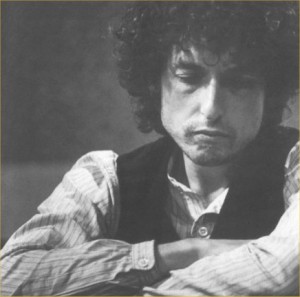
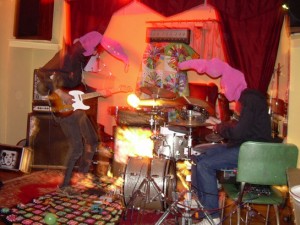
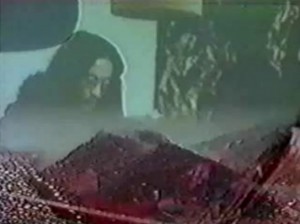


![31 VII 69 10:26 - 10:49 PM / 23 VIII 64 2:50:45-3:11 AM [aka The Black Record]](http://static.rateyourmusic.com/album_images/s601105.jpg)



























![Battiato [aka Za]](http://static.rateyourmusic.com/album_images/s189334.jpg)






